The woman who rifles through New York’s garbage – exposing the city’s excesses
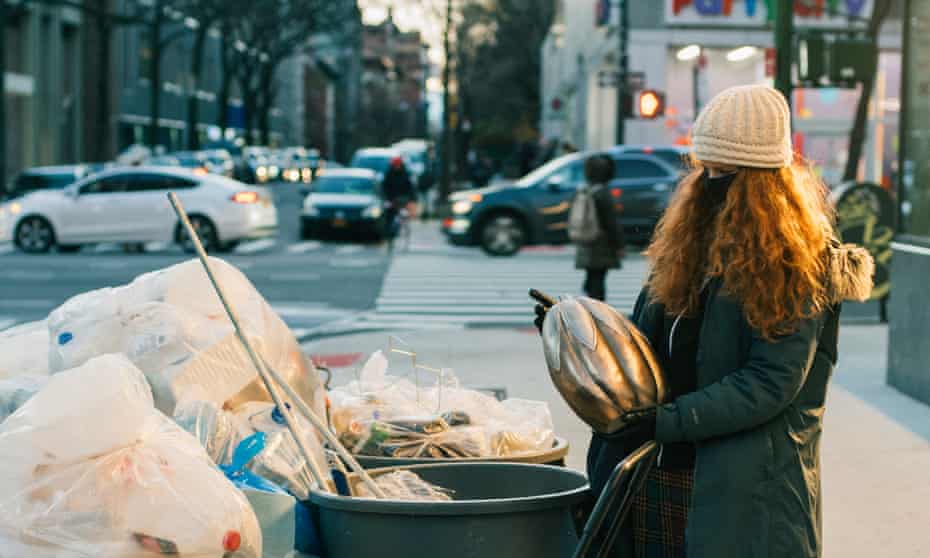
Anna Sacks documents her ‘trash walks’ on social media, shining a light on the everyday shame and indignity of producing and living with so much waste
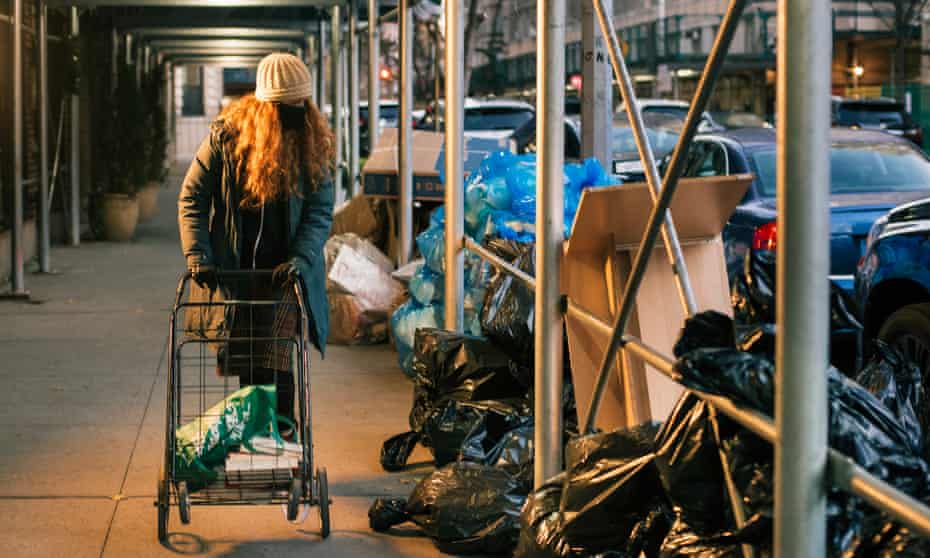
On an ordinary street in the middle of Manhattan, Anna Sacks gets ready to rifle through the trash. But first, she takes out her phone and turns on the camera.
“You can see, they’ve ripped up the RXBars,” says Sacks in the resulting TikTok video, as she documents the depths of this particular bag of trash, plopped outside a CVS pharmacy. Her (puncture-proof) gloved hand maneuvers through the bag to reveal its contents: the aforementioned protein bars; tubes of toothpaste with the toothpaste squeezed out; a depleted makeup palette; a hairbrush that appears to covered in the aforementioned toothpaste. “Ugh,” Sacks manages at one point, before salvaging the hairbrush, noting it just needs to be washed. “It’s so gross that this is what they like to do, as a corporation, rather than help people.”
Sacks’ social media channels are full of moments like this – a visual journey through corporate trash, residential recycling and other stuff that’s just left on the curb. Since 2018, Sacks has been going on what she calls “trash walks” in New York City, rummaging through the city’s discards in search of usable items – and documenting what she finds on Instagram (and more recently, TikTok), under the handle @thetrashwalker. On social media and in real life, Sacks never seems to run out of patience, even when confronted with the scale and pervasiveness of the problem she is trying to solve: our culture of throwing things out, which leads to businesses and consumers alike producing untold amounts of waste. By rooting through the trash in the country’s most densely populated city, Sacks hopes to expose just how much of what we deem to be garbage really isn’t.
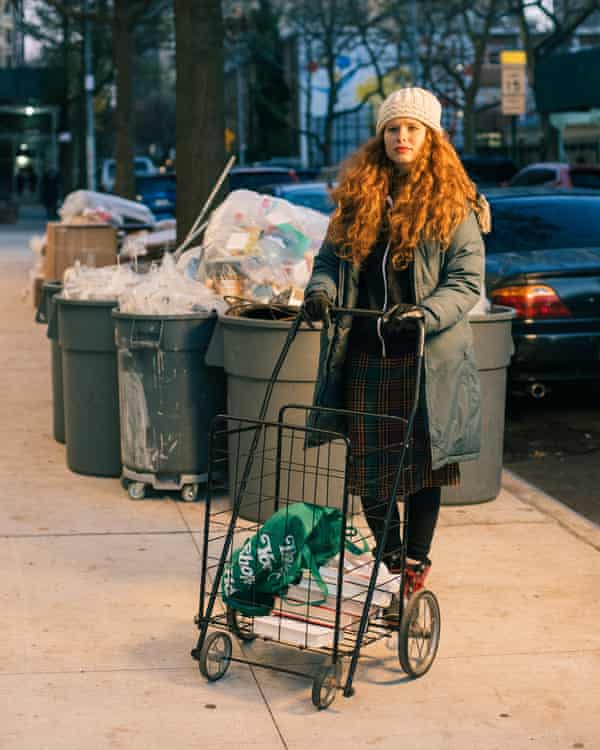
There are other Instagram accounts that highlight the possibilities of dumpster diving and regifting, like @stoopingnyc. But more than publicizing discarded loveseats and Ikea dressers left on the street, Sacks’s work shines a light on the shame and indignity of producing this much waste – by showcasing just a fraction of the usable food, clothing, housewares and more that gets thrown out every day.
Sacks, 30, is an unflappable native New Yorker and environmental activist, with bright, curly red hair and an unwavering readiness to talk about her life’s work. On a trash walk last year, she laughed when I asked if she had to train herself to overcome any hesitancy before digging through people’s recycling. “This doesn’t gross me out,” she said.
“I don’t see myself stopping,” she added at another point. “I do this because I love it and it’s fun and exciting and it relaxes me. I lose track of time.”
Sacks’s trash walks have captured media attention over the years. In 2019, the Today Show joined Sacks on a trash walk, hitting five different CVS locations. In January 2020, the New York Post accompanied Sacks as she went through Starbucks’ trash and found that the chain “throw[s] away a king’s feast of unsold food every night”. (Within a week of their story’s publication, Starbucks announced new goals to reduce landfill waste.)
Earlier this year, Sacks recalls finding “bags and bags” full of outdated decorations and paraphernalia outside a local Party City: New Year’s Eve napkins and tablecloths, Valentine’s Day plates, NFL merch from the Super Bowl. She posted about it in her neighborhood Buy Nothing Facebook group, and took as much home as she could; a few days later, a woman who saw her post came by to take some of the items, hoping to use them in the pediatric hospital where she works.
“Honestly, it’s stuff that never should be made to begin with,” she says. Turning serious, she adds: “But my view is as long as it’s made, it should be used.”
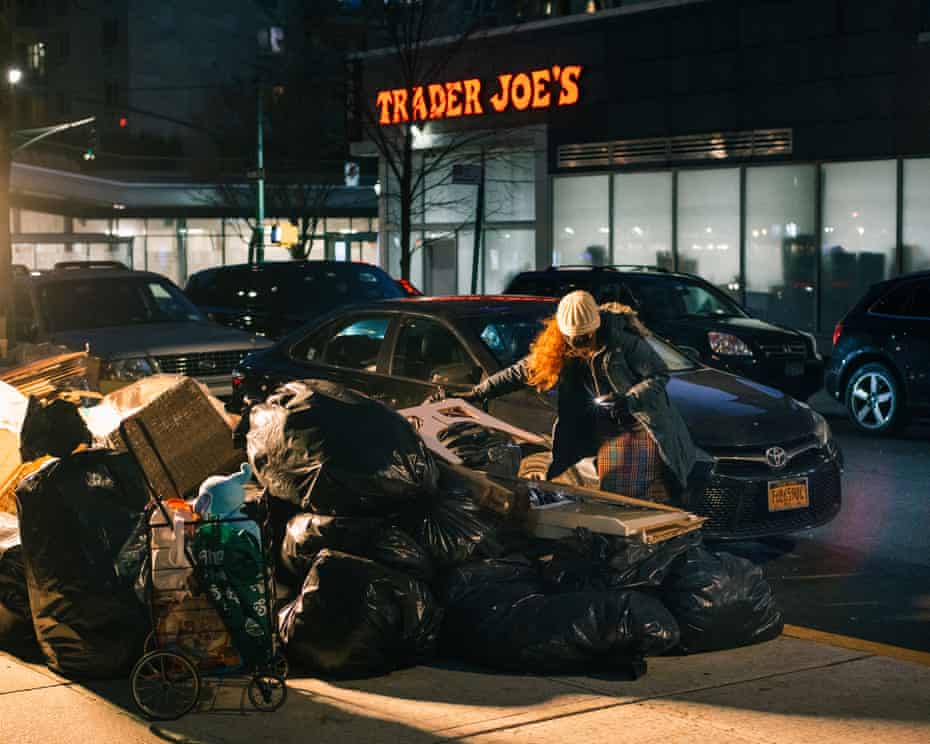
Much of Sacks’s work takes aim at corporations. But she also sorts through residential recycling in her Upper West Side neighbourhood, which she takes as proof that there isn’t enough education around what’s really recyclable and what’s not.
In another video, she digs through a bag of toys, including what look like hundreds of Lego pieces, put out as recycling. “There’s no way this is getting recycled in the normal recycling system,” she says on the video, fist full of Legos. “They’re too small. They’ll literally fall through the cracks.”
Zero-waste influencers have been around a long time, and in New York City, retired sanitation worker Nelson Molina has been showcasing his best trash finds, collected over years on the job, turning a city sanitation facility into a kind of living art project. But what’s different about Sacks’s Instagram is that it reveals the kind psychic pain that comes with bearing witness to – this much waste.
Last year Sacks put out a call on TikTok, asking anyone who had worked in retail and had been instructed to destroy unsold or returned merchandise to share their story. One TikTok user described having to slash an office chair with a box cutter while working at an office supply store.
“It was disgusting,” the user said, adding that their managers later “watched me throw it in the trash, to make sure I would actually put in the trash. And I just – that didn’t feel right..”
This collection of horror stories – she shares the responses she’s gotten on TikTok under the hashtag #RetailMadeMe – captures a dystopian dynamic: asking low-wage retail employees to destroy goods or food that they themselves might actually want or need and not be able to afford.
In another particularly grim video that Sacks received and shared – unrelated to the #RetailMadeMe callout – a live parakeet was found in the trash outside a Petco location.
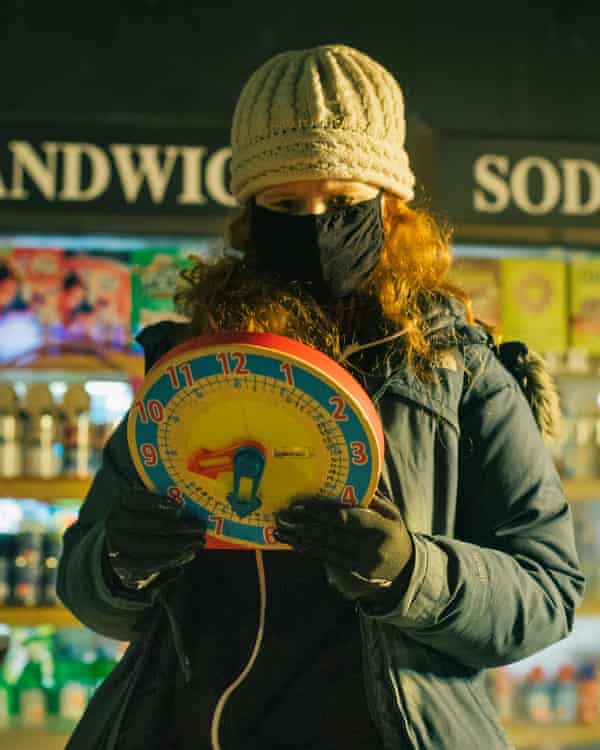
The immense scale of waste requires large-scale solutions
As the climate crisis continues, the need to reduce and divert waste has never been higher. In the 2020 fiscal year, New York City residents produced just under 10,000 tons of waste every day, according to a report from the department of sanitation. Once it’s collected, none of it stays in New York City; roughly two-thirds of Manhattan’s residential waste goes to a waste-to-energy facility in Essex county, New Jersey. The rest of the city’s non-recyclable waste ends up in landfills and other waste-to-energy facilities in upstate New York, New Jersey, Pennsylvania, South Carolina and Virginia.
For decades, dumpster divers and freegans have brought attention to the vast quantities of food that gets thrown out by grocery stores and restaurants every day, and have searched other people’s trash to support themselves. In recent years, the rise of stooping and Buy Nothing groups has hinged on the idea of a economy of sharing, in which goods and services are exchanged freely between people who need them.
But these practices are pretty old. “People finding objects or food or ways of supporting their livelihood from the street [is] as old as the city itself,” says Robin Nagle, a professor at New York University with a focus on waste. Using Instagram to bring more attention to overproduction and waste, she notes, “could be the beginning of – or a push towards – more systemic changes in the flow of material”.
Sacks’s work hinges on the idea that trash could be not-trash if only it were in a different location – if it were retrieved from the waste stream and dropped into, say, your living room. It’s an empowering idea, effective in its simplicity. We all need things – maybe even things that somebody else is throwing out and willing to give away for free. But this idea also has its limits: on my trash walk with Sacks, we passed countless items left out in the recycling – a toaster, a nameplate that said “boss lady”, a self-help book on divorce, buttons for sewing, a full set of dishes and cutlery – all of which were still perfectly useful, but just not to me.
Which is partly why Sacks believes that real change will take big shifts in how corporations operate. In 2019, Sacks sent an email to Larry Merlo, then CEO of CVS Pharmacy, asking why they were throwing away items instead of donating them. The next day, Sacks received a call from a CVS regional manager in New York City; he later said he’d gotten special permission to donate goods from certain stores.
But herein lies the problem of reducing waste: the immense scale. CVS Pharmacy has nearly 10,000 locations across the US and Puerto Rico. “You shouldn’t need to receive special permission from the CEO to form new donation partnerships,” says Sacks. “How are you going to manage that?”
Sacks repeatedly comes back to the idea that retailers could give away unsold or lightly used, returned (but still good) items to their low-wage employees, instead of tossing them, or jumping through bureaucratic hurdles to donate them. This could be an “added perk”, she says, or an additional form of compensation, to bolster employees’ wages.
!['I get so many comments [on Instagram] that say corporations want to donate but they can't because they'll be sued.'](https://i.guim.co.uk/img/media/0ba2a384854535defc75af18c74ec0b89ef0f057/0_2444_4912_2945/master/4912.jpg?width=465&quality=45&auto=format&fit=max&dpr=2&s=5a1063fe76caeaff31244aab529800dc)
But Sacks recognises just how difficult this would be, requiring “a larger change in a corporate mentality of how they view employees”. The environment described by retail workers who have answered her calls for stories is “totally different from what I’ve ever experienced in my workplaces. I’ve never been thought of as not trustworthy or as a thief. So yeah, it [will require] a shift.”
Sacks believes real movement on the problem will also require bold legislation.
In the spring, Sacks left her job at ThinkZero, a zero-waste consultancy firm, and is working on building a coalition focused on passing legislation that would make donating “the obvious choice” for corporations, schools and other groups looking to offload unsold or unused goods. “If you don’t make it a law they’re not going to do it,” she says. “My overall goal [with the coalition] is for it to be bipartisan and common sense.”
Because Sacks’s videos pull back the veneer of corporate pledges to commit to sustainability, they are often shared by followers who say capitalism is the root problem. But Sacks says she finds that argument “polarizing” and that it “immediately alienates” those who equate critiques of capitalism as endorsement of socialism or communism.
“I don’t want to go into a capitalist vs. socialist or communist debate because I think it’s a binary. Can’t we imagine better systems?” says Sacks. “Can’t we imagine an improved system from what we have right now? Can’t we imagine better government regulation?”
But Sacks has found that she has to first debunk misconceptions about what corporations can or cannot do in order for her message to reach people.
“I get so many comments [on Instagram] that say, well, corporations want to donate but they can’t because they’ll be sued,” she says. Yet in 1996, Congress passed the Good Samaritan Food Donation Act in order to create a national standard around the liability faced by food donors, as state laws vary widely. The act offers protection from criminal and civil liability to people who donate food that meets certain requirements to nonprofit organizations. Restaurants and retail grocers are covered under the act, but Sacks argues not enough people or businesses know about it or take advantage of it.
Indeed, the American penchant for viewing corporations as the victims of undue government overreach is on full display in the comments section of Sacks’ Instagram and TikTok pages.
“It’s really an interesting phenomenon, [of] humanizing corporations and thinking of them as humans with feelings,” she says. “There is a lot of trust in corporations and there is distrust in government, and I think those are going to be barriers.”
Some of us are already persuaded of the need for sustainability and a more circular economy; sometimes, the utility of someone else’s trash is obvious. The evening of our trash walk, Sacks showed me the many doughnuts and bagels left in bags outside a Dunkin’. It wasn’t long before a man approached us and asked if he could have some to eat. When he said he wishes he had a plate, Sacks looked through the haul of items she’d just collected. “If you want, I can give you this plastic box,” she said, quick to add it wasn’t clean.
Later that night, as we passed another building’s recycling piles, she stoped to point out a perfectly good bulk dog-food container, which she has seen left out on the street before. “The plastic containers are never-ending,” she says, and keeps walking me to the train.
